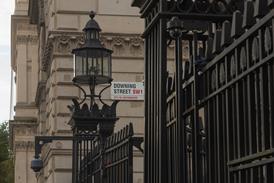Law firms have long thrived on acting for both parties in personal injury and professional liability cases, but new regulations may curtail the practice. Frank Maher explains
While insurers are busy trying to cut law firms out of the claims process, by doing more in-house claims handling and recruiting more in-house lawyers, new rules may create a need for more external lawyers, not less.
It is a change which will impact on defendant lawyer firms and their insurer clients, and which they ignore at their peril.
The problem lies in the potential conflict for a firm acting for both insurer and insured as is common in the UK. Our US counterparts would be surprised that we thought it possible to act for both in the normal course of events.
Acting for both insurer and insured can give rise to a number of tensions. Take a simple but only too common example – a low value motor claim involving a teenage driver.
He goes to see the defence lawyer appointed by his insurer to provide a statement, and during the interview coughs to the fact that he insured the car in his mother’s name to obtain a cheaper premium.
Only too common, but immediately a problem arises. It is a low value claim, so the defence lawyer is probably an inexperienced paralegal or trainee, immediately thrust into the heart of a conflict of interest, representing the insurer but also on the court record, and hence acting for the driver.
The lawyers first letter to the driver will probably say something along the lines: “We have been instructed by your insurers to act for you...” Now he sees his role as anything but.
The lawyer has a conflict of interest: he owes duties to the driver and duties to the insurer. If he carries on acting for both, he commits a serious breach of professional conduct.
It is one problerm that is being addressed by the new Solicitors’ Code of Conduct 2007, and the arrival of the Solicitors Regulation Authority, heralding a tougher regulatory regime.
Conflict of interest is often more acute in professional liability claims. Here many opportunities arise for falling foul of the rules. Issues may be less clear cut, For example, in one valuer’s professional indemnity claim it became apparent on receipt of expert evidence that the valuer could not possibly have inspected the property. This gave rise to issues of cover, much like the motor case referred to above.
“The desire to present a common front defending claims may cause both insurers and their solicitors to lose sight of inherent conflicts
Unlike the defence of motor claims, there will usually be an excess. Settle within the excess, and you save the insurer costs. The position becomes more acute if the insurers wish to argue there are multiple claims with multiple excesses, as happened in The Accident Group claims against solicitors over referral fees, an issue on which views may differ substantially.
Likewise, there may be an issue of whether a claim should be settled within the primary layer, or defended in the hope of avoiding liability altogether.
An insured may also wish to protect his reputation by settling on terms which preserve confidentiality. Here, though, the position will often be protected by a ‘QC clause’ which provides for a QC’s opinion on whether a claim should be defended; in practice QC clauses are rarely if ever invoked.
A claims control clause in the policy may empower the insurer to settle, but that does not mean it can do so without any regard to the interests of the insured: an old case of Groom v Crocker (1939) held that the insurer must act in good faith.
Claims where one or more members of the insured may potentially not be covered give rise to particular difficulty –for example, claims outside the course of practice, or dishonesty claims.
The desire to present a common front defending such claims may cause both insurers and their solicitors to lose sight of inherent conflicts.
Often professional indemnity claims are brought as a way of avoiding paying fees. The insurer may have a claim for fees. Settling the claim by abandoning the claim for fees may seem sensible, but in doing so the insurer may be trying to use the insured’s money to save the insurer the expense of fighting the claim.
Other more complex situations may arise where insurers’ solicitors submit their reports via the brokers, who are of course the agent of the insured. The exception is perhaps in the case of a master policy scheme, though even then brokers may also have arranged top-up or other insurance for their insureds.
In the case of solicitors, insurers may be bound by their agreement with the Law Society to report dishonesty and other cases where they are reserving their rights to the Law Society, which again may give rise to conflicts for the solicitors instructed by insurers.
The new conflict rules for solicitors were brought in last April, but only now are they beginning to appreciate the full ramifications. Insurers’ solicitors who go on the court record are also acting for the insured and owe extensive duties in terms of professional conduct.
“Far greater care will be needed in future in constructing the initial letter to the insured to deal with these issues
These include compliance with the rules on client care, which require solicitors to “explain any limitations or conditions resulting from your relationship with a third party”. This “third party” might be an insurer.
Solicitors must also obtain the agreement of their respective clients who may initially have a common interest in cases of potential conflict. And they should have a plan to manage the situation if the conflict in fact emerges .
The writer’s experience of reviewing files conducted by many leading defendant law firms has revealed many who fall short of the requirements of the old rules, let alone the new. They may therefore expose themselves to disciplinary sanctions and possibly claims, and may also prejudice the prospect of their insurer clients in cover disputes.
The Solicitors Disciplinary Tribunal, which is independent of the Law Society and the solicitors’ profession, has found that perceptions of conflict issues may change with the passage of time. What was regarded as normal, acceptable conduct a decade or more ago may no longer suffice.
In addition, the legal profession faces further regulation from the Legal Services Board if the new Legal Services Bill is approved by parliament in the autumn.
Another problem is that the new rules also require that “where instructions are given by someone other than the client, or by only one client on behalf of others in a joint matter, you must not proceed without checking that all clients agree with the instructions given”.
This may increase the number of conflicts where insureds are less co-operative than desired.
Far greater care will be needed in future in constructing the initial letter to the insured to deal with these issues.
In doing so, defence solicitors will flush out more cases where they cannot properly act for both insurer and insured, or cannot act for all members of the insured.
They will also need to be more astute to the conflicts which emerge later in the life of the claim. These in turn will lead to more cases with separate representation – often at the insurers’ expense under the provision for defence costs, much as they may not like it. IT
Frank Maher is a partner in Legal Risk Solicitors





































